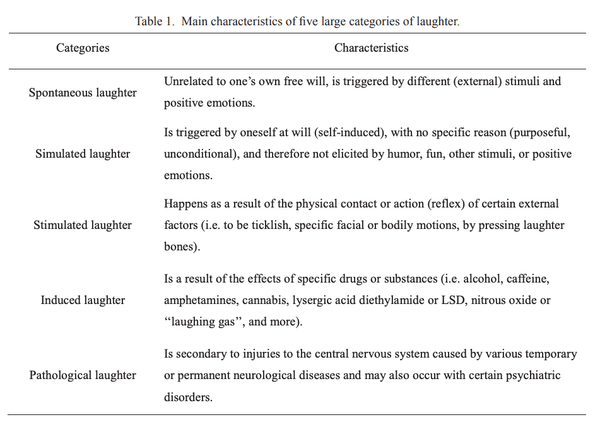Remember when you last had a mirthful laugh? How did you feel after laughing? :) How did you feel when you last cried and let go of all the pain? Do you hug every day or maybe do you hate hugging? Read more about the health benefits of crying, laughing and hugging in this article!
Laughing
It is said that laughter prolongs life. Laughter combines rhythmic contractions of the diaphragm with other audible respiratory movements and various “growls” of laughter. Laughing expresses positive emotional states and responds to a surprising situation. Laughter can also be mixed with crying in strong emotional states.
Hilarious and prolonged laughter has been found to lower blood levels of cortisol and adrenaline, among others. Laughter also increases the amount of serotonin in the bloodstream. The positive effects of laughter on health have begun to be better understood. Laughter therapies have also been developed based on research. They have been found to exercise and relax muscles, improve breathing, stimulate blood circulation, lower stress hormones, raise pain thresholds, and improve mental performance. Laughter therapy has also been found to be an effective means of treating depression, especially in the elderly.


Source: Yim, J. (2016). Therapeutic Benefits of Laughter in Mental Health: A Theoretical Review. The Tohoku Journal of Experimental Medicine 239 (3): 243–249. Review.
Crying
The function of tear fluid is to clean and rinse the surface of the eye. Blinking the eyelids spreads the tear fluid evenly and keeps the eye moist. Tear fluid is excreted more than usual when crying or in situations where the tear reflex tends to protect the sense of sight from external stimuli such as smoke, onion acid, or debris.
Crying is also a typical human way to relieve tension, frustration, resentment, and stress in the context of a strong emotional state. The prevalence and regularity of crying are influenced by age, gender, personality, cultural tolerance, social status, and biochemistry such as hormones and neurotransmitters, among others. Many times crying occurs in difficult situations such as separation, loss, and helplessness, and the context of a strong positive or negative emotional state. Crying can occur either intra-individually (self-soothing) or inter-individually (social support). Of these, crying reflected in the internal space is usually associated with relieving stress and elevating mood. Similarly, crying among people is usually a reflection of a need for attention and intimacy or experienced lack of empathy in an emotionally difficult situation.

Image: Self-soothing in relation to antecedent and response-focused emotion regulation strategies.
Source: Gračanin, A. & Bylsma, L. & Vingerhoets, A. (2014). Is crying a self-soothing behavior? Frontiers in Psychology 5: 502.
In the 1980s, biochemist William H. Frey II hypothesized that crying would be a biochemical way for the body to relieve perceived stress. He based this on the observation that the tears produced by emotional states are different in composition from those produced by irritants.
Emotional tears include pain-relieving endocrine opioids, corticotropin (ACTH), and prolactin, also called milk hormone, which is naturally secreted more in women than men. This may be part of the reason why women cry statistically more often than men. Estrogens, among other things, increase the production of prolactin. High levels of prolactin lead to decreased secretion of sex hormones such as estrogen and testosterone. Studies show that high testosterone levels, in turn, reduce the likelihood of crying. However, high testosterone levels are not associated with a lack of empathy, as may have been previously thought.
On the other hand, culture and society also influence crying: people in richer countries may cry more because they live in a culture that allows it, while people in poorer countries - who presumably may have more reason to cry - do not do so because of cultural norms that disapprove of expressing emotions.
In addition, crying is associated with activation of the parasympathetic nervous system, decreased cortisol secretion, release of nerve growth factor (NGF), and secretion of oxytocin. Cognitive phenomena include increased self-esteem and the discovery of a new perspective on the sad event.
De-stress by hugging
“We need four hugs a day for survival. We need eight hugs a day for maintenance. We need 12 hugs a day for growth.”
– Virginia Satir (1916-1988)
Hugging has been shown in studies to be a very effective way to increase the levels of the love hormone oxytocin in the body. In women (before menopause), regular partner hugging is associated with higher oxytocin levels and lower blood pressure. Copiously hugging and touching couples are likely to be generally healthier than less hugging and touching couples.

Full-body hugging has been found to balance the nervous system, lower cortisol levels in the body, reduce loneliness and fear, increase self-esteem, reduce tension, and increase gratitude. Hugging for ten seconds has been found to increase the body's immunity, reduce depression, and relieve fatigue.
A twenty-second hug, combined with holding hands for ten minutes, markedly lowers the blood pressure and heart rate elevated by chronic stress.
///





























